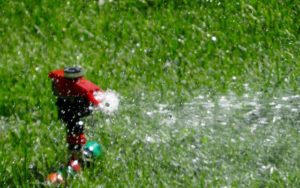Landscaping and Watering
 Summer is an especially important time to save water. Outdoor water use increases residential consumption from 10% to 50% in June, July and August. This summer has been a particularly difficult year with significantly less than average rainfall and the need to water more frequently. Every drop counts to keep your landscaping alive and flourishing.
Summer is an especially important time to save water. Outdoor water use increases residential consumption from 10% to 50% in June, July and August. This summer has been a particularly difficult year with significantly less than average rainfall and the need to water more frequently. Every drop counts to keep your landscaping alive and flourishing.
TIMING IS CRITICAL!
Watering your lawn mid-day will result in a high rate of evaporation and sunburned grass. Roots can maintain plenty of moisture even after several days without rain. Before watering, look for signs that it's needed: patchy areas, a general change in color or footprints that remain in the grass long after being made.
Frequent light watering can actually weaken your lawn by encouraging shallow roots that are less tolerant of dry periods and more susceptible to insect damage. Wet grass can also burn in the hot sun and is vulnerable to disease from mildew and fungus. Test your soil for dryness by digging your finger below the surface of the soil. Water only when the soil is dry to a depth of 1 1/2 inches. When watering, check to see that water soaks down 3-4 inches. This encourages deep root growth.GIVE YOUR LAWN A REST
If your lawn "fades" in the summer, don't panic. Grass becomes naturally dormant during hot, dry periods. It will revive quickly after a good rainfall or when the weather turns cooler.
- Water very early in the morning.
- Never water when it's windy, rainy or very hot.
- Raise the blade level of your mower to 2 -3 inches or more. Longer grass retains more moisture because it shades the roots. It encourages deeper rooting, requires less fertilizer and competes better against weeds.
- Never water faster than the soil can absorb it. Avoid puddling and run-off.
- Be sure your hose has a shut-off nozzle. Hoses without a nozzle can spout 10 gallons or more per minute.
- If you have an automatic sprinkler system, make sure the timer or "controller" is set to water each landscape zone efficiently. Program the controller to operate according to the watering needs of your lawn or garden. Better still, install a rain sensor or soil moisture sensor that turns the system off if it’s raining or if moisture is present in the soil.
- Do not apply fertilizer in the summer - new growth requires more water. Apply in early spring and or fall.
- Aerate your soil in April, September or October to aid water absorption and retention.
PLAN AND DESIGN YOUR GARDEN FOR EFFICIENT WATERING
Be aware of the various zones in your yard (hot/sunny, cool/shady, moist, dry, etc.) and plan your gardens and plantings accordingly. For example, if your have a hot, dry zone, carefully select plants that can endure hot, dry conditions.
CLUSTER PLANTS THAT NEED EXTRA CARE
If you choose shrubs, flowers or vegetables that need lots of sun and moisture, place them near each other. You'll save time and water by watering just one area of your yard.
MULCH TO KEEP ROOTS MOIST
Mulch can serve as a ground cover that reduces water evaporation from the soil and reduces the number of weeds that would otherwise compete with the plant for available soil moisture.
Mulch flowers, shrub beds and trees with pine bark mulch. In your vegetable beds, use salt marsh hay, newspaper (no color pages), black plastic, or better yet, landscape fabric - that allows water to penetrate the fabric but keeps down weed growth. On a sweltering 100° day, a 3-inch mulch can keep the soil underneath up to 25° cooler! Avoid white marble chips that can damage acid-loving plants like rhododendrons. Stones or pebbles are good on shady areas. They shouldn’t be used near the house because they give off too much heat. Ground covers, such as ivy or pachysandra, also prevent evaporation around established shrubs and ornamental trees
.You can't control the weather but you can do your part to make the most of the water available tohelp keep your landscaping alive.
Visit www.agentrising.com for more useful tips to pass on to your real estate clients or to start your real estate career with Agent Rising Real Estate School.
0 comments
Leave a comment
Please log in or register to post a comment